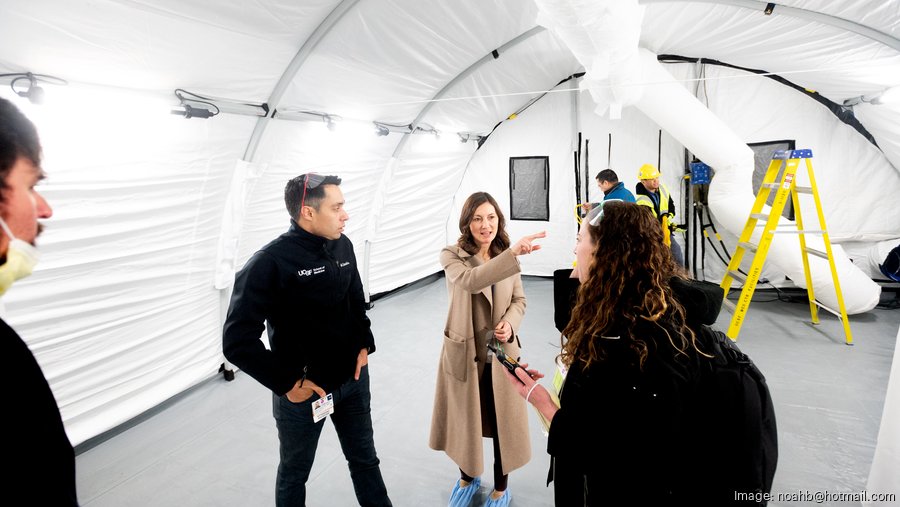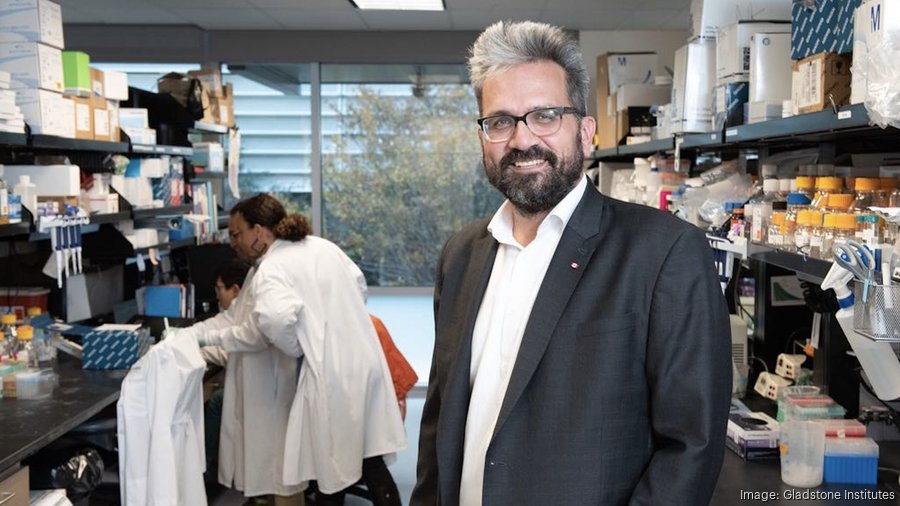Everyone knows by now that the novel upper respiratory coronavirus that causes COVID-19 is a killer. Nevan Krogan wants to know its accomplices.
In a few weeks, Krogan and his partners at UCSF and the Gladstone Institutes — and a network of hard-boiled researchers they worked with globally — turned to scientific gumshoeing in a race against the clock. As a result, they found hundreds of human proteins thought to let the viral killer in the door as well as dozens of drugs that could block the virus by stopping the proteins.
Here's how the science works: After scientists in China deciphered the virus' genome, Krogan and his team separated the 29 or so genes from the virus and studied them and their corresponding proteins in isolation. They then put each of those pieces into human cells, discovering that each viral protein had an average of about 12 human proteins sticking to it.
Now Krogan, director of the Quantitative Biosciences Institute at UCSF, and the global team of detectives he helped assemble with the help of a Bay Area philanthropist are looking at potential COVID-fighting drugs.
We talked to him about how the Quantitative Biosciences Institute Research Group, or QCRG, did its work and how it hopes to stop similar viral killers in the future.
[Edited for length and clarity.]
Your collaboration has identified 300-plus human proteins that interact with this novel coronavirus. Is that while the virus is infecting us? Not during infection. We’re looking at the individual proteins in isolation. The assumption is it’s happening during infections, but we don’t show that because we don’t have the virus in the lab to do those types of experiments. But we’re collaborating with other labs that do have the virus working in New York and in Paris, and they’re testing our prediction for us.
For context, where does that 300-plus number sit in the “greatest hits” of infections? Is that a lot, or is that what we always see? We’ve done this analysis for many other viruses in the past. We did it for 15 HIV proteins and there were about 400 proteins that we found, with Ebola it’s seven proteins and there’s 130 — so this number of “several hundred” is in the range of what we’ve seen before.
But this time you’re discovering this under a much tighter timeframe? Normally these projects take a couple years; we did it in a couple weeks this time. We were racing against the clock because the lab was going to be shut down. We actually got the last piece of data just before the lab shut down. This was a testament to the collaborative spirit that went into this particular project.
It was Feb. 26 when we had the report of the first community spread of the virus in California. I realized at that point that the virus was going to be everywhere and the cities were going to be shut down and our university was going to be shut down. I went into the lab and I said, “Guys, we have to stop everything else we’re doing and focus exclusively on this virus for the next several weeks.”
That was 25 people in my laboratory and that extended to 21 other laboratories in a collaborative fashion that I would argue is completely unprecedented. I’ve never seen that before. We basically worked around the clock in shifts, 24/7, and the last piece of data came off the machine several hours before the university officially closed.
What’s the next step for you or others in this collaboration? Once we had the data, we could remotely analyze it, which we and others have done. It’s a collaboration with computer scientists, not just in San Francisco but in Europe and San Diego and Seattle and all over. We analyze the data and made predictions with chemists and computational biologists about which ones of these human proteins could ultimately be targeted by a drug or a compound.
We were specifically, initially, looking at FDA-approved drugs, with the logic being we’d try to repurpose a drug for one disease for another disease.
But repurposing carries it own set of issues, doesn’t it? The problem with drug repurposing is that Big Pharma doesn’t usually do it because another company has the patent. So why would they put work into something for another disease that another entity was going to make money off of?

Looking at the 300 proteins, we identified 69 drugs or compounds that were known or predicted to target one of those proteins. That included 27 FDA-approved drugs and the rest were compounds in clinical trials or being looked at pre-clinically.
You didn't have the virus to test those predictions? Unfortunately, we didn’t have the virus — we still don’t have the virus growing in San Francisco in the lab. It’s probably going to be a month or two before anyone does.
But we’ve established great collaborations with scientists in New York at Mount Sinai Hospital and the Pasteur Institute in Paris, so we’re sending up drugs and compounds to them. We were able to successfully send out 10 to New York. We don’t want to share the results until we can replicate them. And in Paris they’re now testing these drugs and compounds — we sent out another 22 and we’re trying to send out another 35.
And you’re at home, sheltering in place. I’m at home and we’ve been coordinating these relationships around the world and digging into the data. We actually had a call this morning [Friday] with discovery scientists at UCSF — 152 of them. We got a Zoom call and split up into different groups
So this is an all-in kind of effort. Yeah. It’s a type of effort I’ve never seen before. I’m director of the Quantitative Biosciences Institute at UCSF and for the last three and a half years since its inception we’ve really been trying to facilitate these types of collaborations and breaking down silos — not just in San Francisco but around the world. So I think we were in a very unique position because we built up this infrastructure, we made these connections and brought everyone into action at the same time.
We broke down silos around 22 different laboratories at UCSF, we broke down silos around different institutions and we also broke down silos between academia and pharma.
Which companies? We’re collaborating now with a number of different pharmaceutical companies, including Roche. I’ve never seen anything like this, and I think we’re setting up a new paradigm of how to do science, a new infrastructure, a new foundation. I think we’re setting something up for the next pandemic, for COVID-22 or COVID-24, for the next virus that comes along or the next disease we want to study.
If there’s a silver lining, that’s it. We’ve all realized how fast things can move.
Science is so siloed and it’s so individualistic and so competitive — one person wins the Nobel Prize, one person gets a grant — you don’t get rewarded for doing team science. But if we all work together, look how fast things can go.
How soon can one of these repurposed drugs get into clinical trials? Roche is saying, “Whatever you guys find, we’re going to put it into a clinical trial immediately.”
The great thing about targeting drugs that are already being put into patients for other diseases is that they’ve already overcome toxicity issues, or I think it would be less likely to have toxicity. You see hydrochloroquine and some of these other things already in clinical trials, so if we have something promising in the next few weeks — this is not my area of expertise — but it seems like it would be expedited very quickly.
What’s the key here — finding blocking one protein or a series of proteins? Normally people look to target viral proteins — that makes sense: The protein gets into your cell and you want to target them. However, viruses, especially RNA viruses, mutate and you get resistance. That was the big problem with HIV, and the big breakthrough with HIV was to have three different drugs targeting three different viral proteins.
One of the advantages of targeting human proteins is we don’t mutate as fast as a virus. When you look at viruses, you see the same proteins coming up again and again — many different viruses use similar proteins in our cells. So when the next coronavirus comes along, you don’t have to start from scratch, if that virus uses the same human protein as the COVID-19 virus.
The logic here is host-directed — don’t target the virus, target the human protein that the virus needs — and if you use pre-approved drugs there’s less of a problem with toxicity. The other plus is hopefully we can get to a pan-pathogenic strategy that one particular drug can make a difference against many different viruses, including the next pandemic.
Is it better to get something now, in a short time frame, that’s maybe less effective, rather than trying to develop the “perfect drug”? This work provides insight into both. The logic is that you have people at the end of their lives — they just need some help to get over the hump. This isn’t like a drug you have to take for years; you have to take it a couple of days and hopefully it has an effect. Looking short term, for something that could work quickly — that’s a great strategy — as is trying to come up with more of a “perfect drug” or a vaccine or an antibody treatment.
All fronts should be pushed on as hard as possible, but right now we need something. Maybe there’s something that already exists in the cabinet of these pharmaceutical companies that could be used to fight off this infection tomorrow.
What role does philanthropy playing in this? Ron Conway has been a saint. He’s really leading the charge in helping us raise money for this initiative. Federal grants are attached for specific disease areas and specific projects where there are timelines and milestones — I get that — but it’s so advantageous to have flexible money that can pivot quickly and can be used on an upcoming project or a disease like this. Philanthropic money is so crucial to do these flexible things.
We can try out a brand-new idea — a risky idea that you couldn’t get funded by traditional means — or be prepared to fight a virus, a pandemic that no one in their right mind could have predicted. I think a lot of people were predicting something like this, but maybe not to this level. So philanthropy allows you to do unique things and pivot quickly when the need arises.
Bay Area employees
| Rank | Prior Rank | Business name/Prior rank |
|---|---|---|
1 | 1 | Genentech |
2 | 2 | Gilead Sciences Inc. |
3 | 3 | BioMarin Pharmaceutical Inc. |





